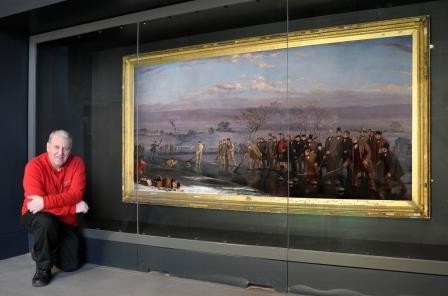Paul McMahon
Visitor Services Assistant
Paul McMahon is a Visitor Services Assistant at Summerlee Museum of Scottish Industrial Life. Paul spent his early working life in steel and manufacturing, and has lots of stories to tell visitors about what life was really like working in industry.
In the ‘70s, at the age of seventeen, Paul started working for British Steel at the Clyde Alloy in Wishaw, at their Number 1 Rolling Mill. The mill was hand-worked, meaning the steel would be moved through the rolling mills by men using tongs. It was hard work and very dangerous at times; there were many accidents, mainly burns as the metal was red hot. Health and safety was practically non-existent. Paul had an accident: one night they were moving red hot bars and one hit Paul’s flared jeans, causing them to catch fire and badly burn his leg. Following the accident, Paul’s manager agreed that everyone should be issued with flame resistant trousers. Paul remembers that the wages were good, there was a good bonus scheme, and a good camaraderie among the men.
Paul left the steel works to work at Siporex in Carfin. In the ‘70s it was easy to leave one job and start another, unlike today. He made concrete blocks, slabs, and bricks, which were used in coal mines. This was heavy manual work as some blocks were large and had to be lifted by hand. It was a very dusty atmosphere from the concrete mix. Even though Paul had an accident, he liked working there and wonders sometimes if he would still be working there today. But, as the Thatcher Years continued, companies were closing; Paul was made redundant.
Paul later went back to the steel works, working at Ravenscraig at the coke ovens. As furnaces are made from brick they eventually cracked and weakened, and had to be rebuilt. So the ovens were knocked down to the ground and rebuilt using special brick, high in silicon, imported from Holland. The wages were really good at the ‘Craig and it was said to be a job for life. Again, unfortunately, the mill closed during the Thatcher Years, and that was the end of Paul’s industrial career.
Paul’s favourite thing about the Museum is that it has plenty of noise! He thinks it’s a great place to explore. People are allowed to talk and be themselves, with lots of space and hands on objects, giving people a visual representation of what industry was like in the past.
When talking to visitors, Paul loves to tell them about the painting of The Curlers at the Rawyards by John Levack, painted in 1857.
Scotland invented the winter sport of curling. North Lanarkshire played its part in the story of curling as Kilsyth Curling Club is the oldest in the world. In Victorian times, curling was a popular winter pastime largely played by farmers, businessmen, and some workers. In the painting by John Levack there are two games taking place: one in the foreground; and one further back to the left. There is a four man team playing. Thomas Chapman plays a stone; he was the landowner of Commonhead. Levack captures the movement of the stone very cleverly by painting a dog trying to give chase. James Waddle of Whinhall and Claude Storrie are the sweepers. Gavin Black is giving direction; he was the owner of the land east of Airdrie, Rawyards, where the game is being played. The men watching the game are all well-known land owners and businessmen of Lanarkshire. In the distance you can see a coal mine.
The painting is, in many ways, Airdrie's modest Night Watch (painted by Rembrandt in 1642) as it shows its top citizens in action. Levack has captured a moment in time: a winter’s day of the 1850s, when landowners, industrialists, and businessmen were playing in their local curling team.



